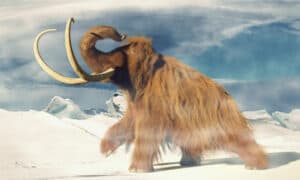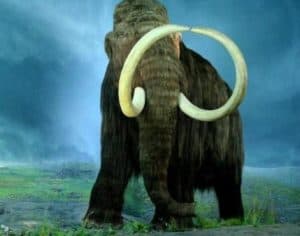Mammoths lived on the earth for millions of years, but they started to die out 10,000 years ago, finally going extinct 4,000 years ago. Their close relative, the African elephant, is still alive today, so how did mammoths go extinct and why?
Let’s find out what happened to this huge majestic animal that roamed the grasslands and frozen habitats of Ice Age earth.
How Did Mammoths Go Extinct?
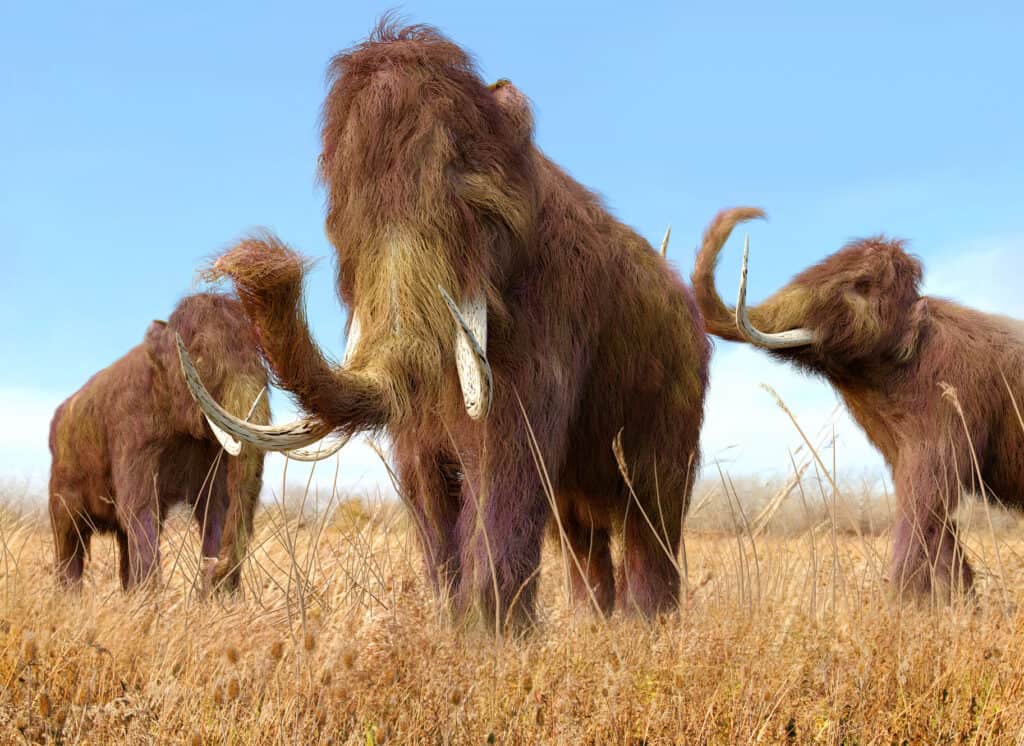
Mammoths began to decline 10,000 years ago. The last mammoths died 4,000 years ago, and the species went extinct.
©iStock.com/Aunt_Spray
It’s most likely that mammoths went extinct because the climate changed, and there was less available food.
Scientists still debate exactly why mammoths went extinct. Theories put forward include viruses, meteor strikes, and human hunting, but it’s climate change that most scientists agree on, and when the population was reduced, human hunting sealed their fate.
When the climate warmed up, and we left the last ice, it became much wetter, and the food mammoths ate declined. This article in Nature journal debates how and why so many megafauna species died out at the same time, including all ten species of mammoth.
Mammoths had survived previous climate changes because they had been around for millions of years, but the last climate change was so rapid they couldn’t adapt. Trees and wetland plants took over, and the mammoth’s grassland grazing habitats disappeared.
When Did Mammoths Go Extinct?
Woolly mammoths went extinct around 10,000 years ago, with an isolated population clinging to Wrangel island in the Arctic Ocean until 4,000 years ago. Before this, they had roamed most of the planet’s frozen landmass in large numbers.
Why Did Mammoths Go Extinct But Not Elephants?
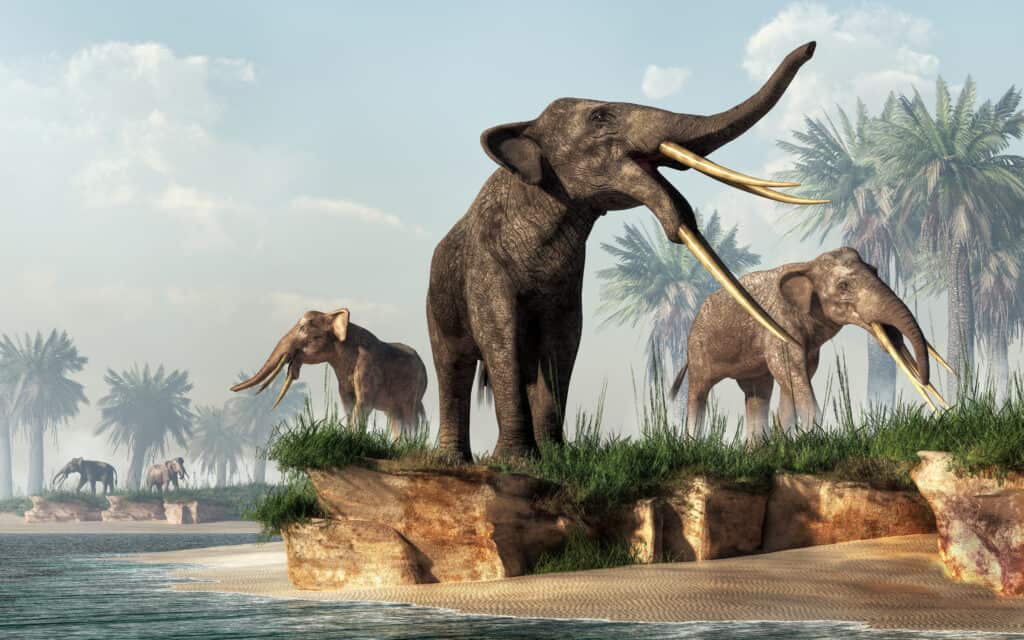
Gomphotheres had four tusks and went extinct around 10,000 years ago
©Daniel Eskridge/Shutterstock.com
This is another question debated by scientists, but no one is sure about the answer. The most likely reason put forward by experts is that mammoths couldn’t adapt to the quickly warming climate in time.
Mammoths and elephants are descended from the same common ancestor, and when the species diverged, elephants inhabited warmer regions of the earth, like Africa, Asia, and Europe. This meant they had a lot longer to adapt to a warmer climate, such as losing body hair and eating a different diet.
Mammoths grazing the frozen areas of the world couldn’t adapt quickly enough when the ice sheets melted, and Ice Age ended.
Another elephant-type species was the gomphotheres. They lived in the Pleistocene and Holocene eras and looked more like modern elephants, except they had four enormous tusks. Gomphotheres also grazed grasslands and went extinct around the same time mammoths did.
How Big Were Mammoths?

Perfectly preserved baby mammoths have been found in the Siberian and Yukon permafrost.
©IG Digital Arts/Shutterstock.com
Mammoths were between 9 and 11 feet tall. The tallest mammoth was the Steppe mammoth (Mammuthus trogontherii). This mammoth was 13-15 feet tall at the shoulder and weighed 8 tons. A woolly mammoth was smaller at roughly 9.5 feet and weighed 6 tons.
A perfectly preserved baby mammoth is on display in the Natural History Museum, London, England. She died 42,000 years ago and was discovered in 2007 by a Siberian deer herder. She weighs 110 pounds (50kgs) and is 51 inches (130 cms) tall.
Did Mammoths kill Humans?
Mammoths were herbivores, and they didn’t hunt humans. It’s possible that humans were hurt or killed by mammoths in the same way people are sometimes hurt by elephants today.
A hunted, angry mammoth would most likely charge and lash out to protect itself. Humans may have been killed this way over the 2,000 years the two species lived together.
Were Mammoths Bigger Than Elephants?
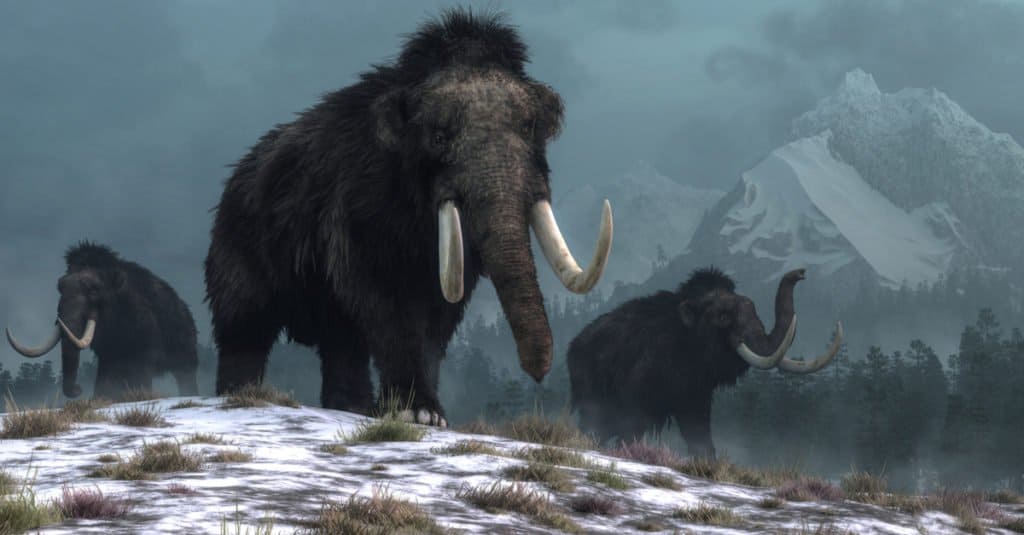
The Steppe mammoth was bigger than an African elephant at 13-15 feet tall.
©Daniel Eskridge/Shutterstock.com
There were ten species of mammoth, but the one most people think of is the woolly mammoth (Mammuthus primigenius). They were about the same size as the modern African elephant, but their tusks were larger, they had a hump on their back near their shoulders, and they were covered in shaggy fur to keep warm.
However, the Steppe mammoth was bigger than an African elephant at 13-15 feet tall, and the pygmy mammoth was smaller varying from 4.5 to 7 feet.
When Were Mammoths Alive?
Woolly mammoths lived about 10,000 – 4,000 years ago during the Pleistocene and Holocene. They overlapped humans by about 2,000 years and are frequently depicted in their cave art.
Humans also used mammoth bones to build shelters and make harpoons from their massive tusks. Archaeologists discovered some of the world’s oldest known musical instruments carved from mammoth ivory in 2008. They found the 30,000-year-old fragments at Hohle Fels, a stone age cave in Southern Germany.
What Were Mammoths Tusks For?
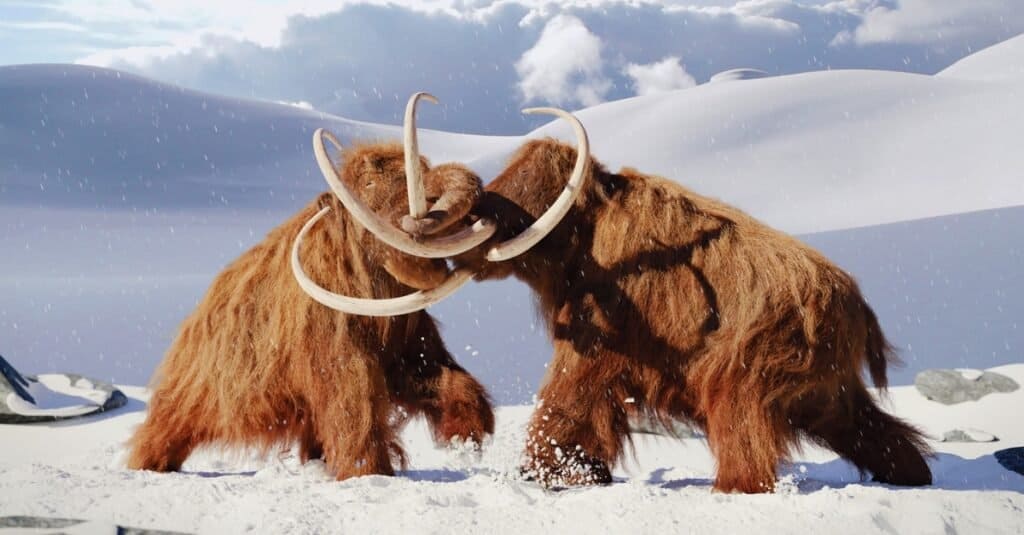
Wooly mammoths went extinct around 4,000 years ago.
©Dotted Yeti/Shutterstock.com
Despite their large and frightening appearance, mammoths probably didn’t use their tusks for fighting.
Instead, these large herbivores used them to clear snow away from the grass that formed part of their diet. It’s also possible large tusks attracted potential mates and warned off rivals.
The largest known mammoth tusks are 14 feet (4.2 meters) long and weigh 201 pounds (91 kilograms). Males had the largest tusks, but females had tusks too. Fossilized specimens indicate female tusks were around 5-6 feet long (1.5-1.8 meters).
Were Mammoths Alive at the Same Time as Dinosaurs?
No, mammoths weren’t alive at the same time as dinosaurs. Dinosaurs died out around 65 million years ago, and mammoths evolved two million years ago. There’s a big gap!
Where Mammoths Elephants?
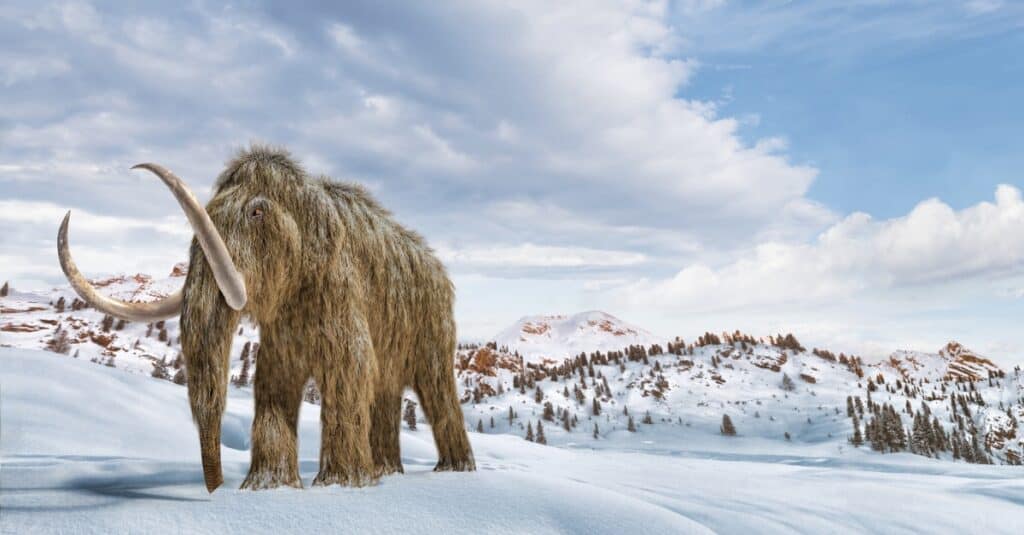
The wooly mammoth was one of the last mammoths to emerge.
©iStock.com/leonello
Yes, woolly mammoths were a species of elephant. They have nearly identical DNA.
Today’s elephants and woolly mammoths had a common ancestor and split into separate species around 6 million years ago. Each species roamed and inhabited new territories. Elephants in warmer climates and mammoths in cooler areas.
Are Mammoths Coming Back?

Even though humans didn’t cause the last ice age, the mammoths’ fate is a warning of what can happen due to climate change.
©PradaBrown/Shutterstock.com
Not yet, but who knows what scientific advances might bring in the future.
Because mammoths lived in very cold areas, we have astonishingly well-preserved bodies. Mammoth bodies have been found in the permafrost of areas that didn’t melt at the end of the last ice age.
Scientists could possibly bring mammoths back using their preserved DNA in the future. Fingers crossed we get to see these amazing animals once more.
So how did mammoths go extinct? No one knows for sure, but it’s most likely this Ice Age giant went extinct slowly due to climate change. Human hunting put pressure on their dwindling numbers until the last few mammoths eventually died out.
Even though humans didn’t cause the last ice age, the mammoths’ fate is a warning of what can happen due to climate change.
The photo featured at the top of this post is © PradaBrown/Shutterstock.com
Thank you for reading! Have some feedback for us? Contact the AZ Animals editorial team.



